PPE Selection
» Hot Work
|
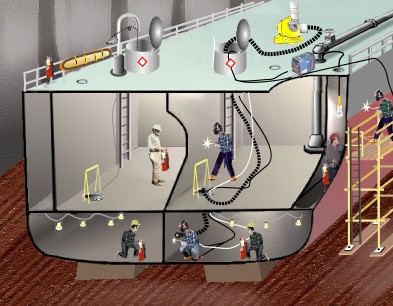
Figure 1: Illustrates a "safe" set-up for hot
work where PPE is required.
|
The OSHA
Hierarchy of Controls
- Engineering Controls
- Administration Controls
- Personal Protective Equipment (PPE)
|
|
Hot work exposes workers to:
- Molten metal
- Toxic gases
- Fumes and vapors
- Harmful radiation
- Excessive noise
- Electrical shock
- Fire hazards.
Appropriate personal protective equipment (PPE) must be selected to protect the worker
from these hazards. [1915.152] Fire watches in the area will require similar PPE.
The PPE specified for hot work will protect
the worker from illness and injury during hot work operations. Hot work operations include:
Each of these operations may present unique hazards. Use of the following PPE
will provide protection:
Review the
General
Shipyard Worker PPE before
proceeding with this section.
|
|
|
Gas Welding and Cutting |
The PPE required when performing this operation must provide
protection from:
- Hot metal,
- Metal fumes and welding gases,
- Noise from high oxygen-burners
- Infrared Radiation
PPE must be used if adequate engineering and administrative controls
are not feasible to control the hazards. Each welding or cutting
operation, depending on the the materials welded on and the type of of
welding method, has specific safety and health hazards from which
workers must be protected. A Hazard Assessment is required by
1915.152 to
protect workers from the hazards associated with these operations.
|
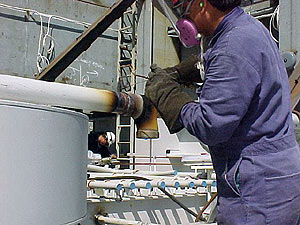
Figure 2: Worker brazing on a pipe. |
 Back to Top
Back to Top |
|
|
Electric Arc Welding |
The PPE required when performing this operation must provide protection
from:
- Ultraviolet and infrared radiation
- Metal fumes and welding gases
- Electrical current
- Hot metal
- Noise
PPE must be used if adequate engineering and administrative controls
are not feasible to control the hazards. Each welding or cutting
operation, depending on the materials welded on and the type of of
welding method, has specific safety and health hazards from which workers
must be protected.
A Hazard Assessment is required by
1915.152 to protect workers from the hazards
associated with these operations.
|
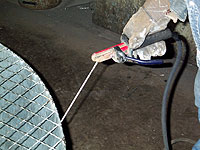
Figure 3: Arc welding lead (stinger).

Figure 4: Radiant energy and gases from arc welding. |
 Back to Top
Back to Top |
|
|
|
Carbon Arcing/Plasma Arc Cutting |
The PPE required when performing this operation must provide protection
from:
- Noise
- Fumes and gases
- Ultraviolet and infrared radiation
- Electrical current
- Hot metal
PPE must be
used if adequate engineering and administrative controls are not
feasible to control the hazards. Each arc cutting operation,
depending on the the materials used and the type of of application, has
specific safety and health hazards from which workers must be protected. A Hazard Assessment is required by
1915.152 to
protect workers from the hazards associated with these operations.
|
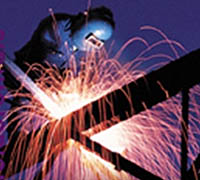
Figure 5: Welder carbon arcing. |
 Back to Top
Back to Top
|
|
|
Respiratory Protection |
Hot work performed on the materials list
below have special requirements as follows:
Confined and Enclosed Spaces
- Hot work performed on surfaces containing lead, cadmium, or
mercury require an air-line respirator to be used if local exhaust
ventilation is not provided or effective. [1915.51(d)(2)]
- Hot work performed on surfaces covered with toxic preservatives
require an air-line respirator to be used if toxic coatings have not
been stripped back at least four inches. [1915.53(d)(1)]
- Other workers exposed to the same atmosphere as the worker must be
protected in the same manner. [1915.51(d)(4)]
- Hot work performed on beryllium requires local exhaust ventilation
and air-line respirators. [1915.51(d)(2)(iv)]
- If the ventilation equipment blocks access to the space, air-line
respirators as well as a stand-by employee must be available. [1915.51(c)(3)]
Open Air
- Hot work performed on surfaces containing lead, cadmium, or
mercury require air purifying respirators to be used. [1915.51(d)(3)]
- Hot work performed on surfaces covered with toxic preservatives
require a filter type respirator to be used. [1915.53(d)(2)]
- Other workers exposed to the same atmosphere as the worker shall
be protected in the same manner. [1915.51(d)(4)]
- Hot work performed on beryllium requires air-line respirators to
be used. [1915.51(d)(3)]
|
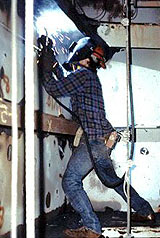
Figure 6: Welder with air-line respirator.
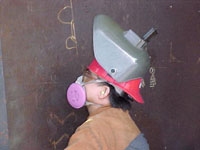
Figure 7: Welder with air-purifying
respirator.
|
Note: There are additional PPE
requirements for
Health
Related Hazards (such as, Lead [1910.1025],
Arsenic [1910.1018], Asbestos
[1915.1001], Cadmium
[1910.1027]).
For more detailed
information, review
Respiratory
Protection.
 Back to Top
Back to Top |
|
|
Eye and Face Protection |
Hot work always produces significant eye and
face hazards, including exposure to ultraviolet (UV) and infrared (IR)
radiation.
Welding,
Cutting and Burning Goggles
- Dark cutting or burning goggles must be
used to protect the eyes from UV and IR light.
- A face shield used in conjunction with safety goggles or glasses may be
used when necessary.
- The proper lens shade number for the operation must be used. [1915.153(a)(4)]
Welding Hood with Dark Glass
- Welding hoods with appropriately dark glass viewing ports must be
used while carbon arcing to protect the worker's face, neck, and eyes
from the arc’s UV and IR light.
- The proper lens shade number for the operation must be used. [1915.153(a)(4)]
|
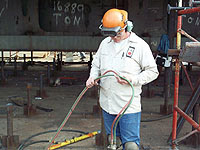
Figure 8: Burner with goggles inspecting
hose.

Figure 9: Arc welding with hood. |
 Back to Top
Back to Top
|
|
|
Protective Clothing |
Hot work produces burn hazards in the form
of heat, sparks, slag, and light radiation.
- Protection from sparks and slag must be provided. (1915.157)
- Note: Leather or other fire retardant garments provide such
protection if they are free of flammable or combustible
materials such as oil, grease, or solvents.
- To minimize burn hazards, remove all combustible items such as
lighters or matches from pockets.
- To prevent slag and sparks from being caught in clothing, tape
pockets and avoid wearing frayed clothing.
- Protection from carbon arcing flash (UV and IR light) is required. Cotton or wool long-sleeved and long-legged clothing can
be used.
- Fire-retardant hoods should be used.
|
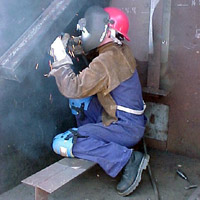
Figure 10: Welder with protective clothing. |
 Back to Top
Back to Top |
|
|
|
Foot Protection |
Hot work operations usually expose the
worker’s feet to the hazard of falling or dropped objects, and sparks and
slag.
- Spats with safety shoes may be used in lieu of high-top boots.
- High-top safety boots should be worn with the legs of the protective
clothing over them to prevent slag from entering.
- Note: Safety boots should be fully laced or zipped. This gear protects the
feet from falling or dropped objects.
|

Figure 11: High-top safety boots. |
 Back to Top
Back to Top
|
|
|
Hand
Protection (e.g., Gloves) |
Hot work operations expose the worker’s
hands to burns and cuts.
- Long-cuffed leather gloves free of flammable or combustible
materials must be used while carbon arcing.
- Leather gloves (or equivalent) free of flammable or combustible
materials must be used while welding, cutting, or burning. [1915.157]
|
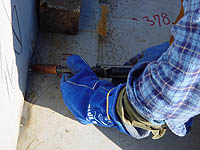
Figure 12: Welder leather gloves. |
 Back to Top
Back to Top
|
|
|
| |
|

